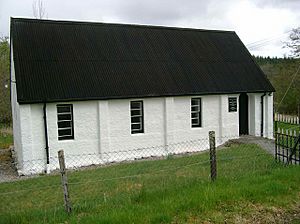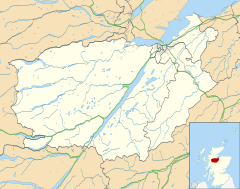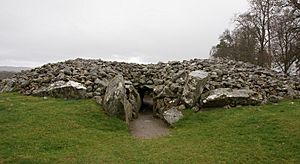Corrimony facts for kids
Quick facts for kids Corrimony |
|
|---|---|
 Corrimony Church |
|
| OS grid reference | NH382303 |
| Council area | |
| Country | Scotland |
| Sovereign state | United Kingdom |
| Post town | Drumnadrochit |
| Postcode district | IV63 6 |
| Police | Northern |
| Fire | Highlands and Islands |
| Ambulance | Scottish |
| EU Parliament | Scotland |
Corrimony (Scottish Gaelic: Coire Monaidh) is a small village in the beautiful Highlands of Scotland. It sits at the western end of Glenurquhart, a lovely valley. Corrimony is part of the Highland region.
The village is about 13 kilometers (8 miles) west of Drumnadrochit. It is also about 32 kilometers (20 miles) southwest of Inverness. Corrimony is a quiet place, but it has a rich history and amazing natural features.
Discovering Corrimony
Corrimony is famous for its ancient sites. These include a special stone called Mony's Stone. It also has the well-known Corrimony chambered cairn.
Ancient History of Corrimony
The Corrimony chambered cairn is a very old burial monument. It is part of the Clava group of cairns. These structures were built over 4,000 years ago. Imagine, they are older than the pyramids of Egypt!
The cairn is a circular stone structure. It was used to bury important people long ago. Around the cairn, there are 11 tall standing stones. These stones add to the mystery and ancient feel of the place. They show how important this site was to people thousands of years ago.
Nature and Wildlife
The River Enrick flows right past Corrimony. This river travels through Glenurquhart. It eventually empties into the famous Loch Ness.
Along its path, the River Enrick creates a beautiful waterfall. This waterfall is known as Corrimony Falls. It is located just south of the village. It's a great spot to see the power of nature.
An area of upland to the south of Corrimony is a special nature reserve. The RSPB (Royal Society for the Protection of Birds) owns and manages this land. It is called the Corrimony nature reserve.
The reserve covers a large area, about 1,531 hectares. The RSPB bought it in 1997. Their main goal is to bring back the ancient Caledonian Forest. This forest is very important for many types of wildlife. They especially want to help the Black Grouse. This is a type of bird that needs these forests to survive.



